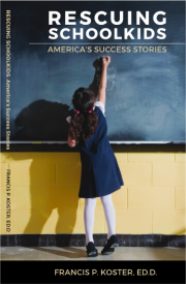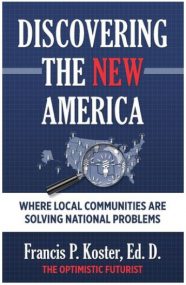Welcome to America's Optimistic futurist
Proven ways to improve kids' learning
without messing with teachers.

Need a Partner? Try the U.S. Department of Energy's Teaming Partner List.
Energy costs too high at your school? Learn about DOE's Qualified List of Energy Service Co's
NEW Subscriber?
Find Past Newsletters of interest, below!
Newsletter of the Week
Surprise! Bringing about student weight loss improves learning and graduation rates. And North Carolina's public K-12 schools show up badly in national rankings.
You can fix this!
Adults need to begin to act on the fact that one out of every five of our school kids are obese.(1) These kids do not learn as well, and have healthcare costs around $1,000 more every year than a child with a healthy weight.(2)(3) According to the Centers for Disease Control, as these obese kids mature, they are likely to have their life expectancy shortened an average of 14 years.(4)
The number of obese school kids has doubled in the past 20 years and continues to increase. The loss of years of healthy life, and the cost of treating the weight-caused illness that emerges when they become adults (diabetes, heart conditions, joint destruction) is a national disaster unfolding before our eyes. But most people do not see it, because weight gain everywhere in our society is now the new normal. When women buy a dress size 8 today, it is equivalent to a size 16 fifty years ago, so no alarm bell goes off. A size 8 fits, right?
If one in five of our school kids has serious and expensive long term health risk, what should educators do? This is a tricky issue, because calling out a child for being overweight can cause parental outrage, child shame, and hostility toward the messenger. On the other hand, if no one brings up the subject or tries to change the child's behavior, we are not acting as responsible adults. And the child will lose many years of life.
Our culture is very divided right now about topics that require compromises between individual rights and a greater good, and it is difficult to have a conversation about topics that make people emotional.
In this case, we have a choice – keep our mouths shut, or save lives.
Below you will find some stories about how school systems have instituted successful programs that bring about healthier weight in students.
You are one of 14,000 North Carolina recipients on this mailing list - almost all of which are engaged in oversight of the K-12 educational system in some capacity. Our goal is to inform you of actions that can be taken OUTSIDE THE CLASSROOM to improve student learning.
When we introduce you to topics like controlling obesity, it is our hope that you will step into your leadership role and ask what your schools' staff needs to capture these opportunities.
Our experience is that you will be more successful in bringing about positive change if you can present success stories for your team to emulate--so that kids get healthy, learn more, school rankings go up, and local property values increase.
Everybody wins only if everyone plays.
Success stories about school systems' obesity campaigns
The first thing you need to know is that some school systems have been successful in reducing obesity in their students. One key lesson of these success stories is that bringing about change is a long-term project. It does not have to require a lot of staff time, or conflict - but it requires tenacity.
There are some key ingredients:
- No criticism - just affirmation of positive behavior, both of the at-risk child, and of their friends whose behavior they should imitate.
- Aiming messaging at students alone does not work. You must involve the parents via meetings, email, and school health visits.
- The messaging has to include steps to be taken outside the classroom.
- Efforts that involve a high number of male adult participants/message recipients are more successful.
- Diet is key - as is educating parents that when they are presenting food at dinner, or ordering in a restaurant, they are also teaching and role modeling (without even talking!).
- Drinks that contain artificial sweeteners are key - artificial sweeteners actually cause weight gain!
- Exercise is necessary.
Quick techniques your school can start immediately
A) Make it fun - Make activities "something they look forward to, not dread. Asking kids to run around a school yard track may not be as rewarding for them as playing 'dodgeball' or 'capture the flag'. Turning them lose in a playground does not result in as much vigorous activity as throwing some balls onto the playground."(5)
B) Weave the subject of nutrition into math classes. Instead of asking how long it will take to fly from point "A" to point "B", ask them how many calories are needed to gain a pound, or how much exercise of various types will result in losing a pound. Get your algebra teachers involved. You can see samples at https://drpolak.wordpress.com/2016/01/15/how-an-average-2-000-calories-a-day-diet-inspired-a-math-lesson/.
C) In learning environments where the kids know how to read, label activities like climbing a stairway with the number calories that were burned. A sign placed at the top of the stairs saying "You just burned 5-10 calories by climbing these stairs" helps students understand why they gain weight from eating a 200-calorie candy bar.
D) Involve the entire family with a purpose-driven, steady stream of emails aimed at both the parent and the student.
Longer term interventions
A) Upgrade school-provided food to a healthier standard than the basic and obsolete minimum standards now in place. School lunch programs have standards that must at least comply with existing federal standards, but states can impose tougher standards. The evidence shows that "[i]n states that exceeded USDA standards, the difference in obesity prevalence ... was 12.3 percentage points lower compared with states that did not exceed USDA standards."(6)
In April of 2024, the national nutrition standards were changed, with implementation to start in Fall of 2025. Among a long list of changes is a reduction in added sugar content. Schools will also have the option to require unprocessed agricultural products to be locally grown, raised or caught when making purchases for school meal programs, making it easier for schools to buy local foods. Additionally, starting in Fall 2025, schools will have limits on the percentage of non-domestic grown and produced foods they can purchase.
Your school system can become a stimulus to local economic growth by buying local produce, vegetables, fruit or meat/fish.(7)
Acting as a responsible adult by doing these things does not mean you have to pick a fight. You can quietly have a positive impact on your community by introducing quiet changes into your school environment.
The kids look up to you – make sure you deserve it!
=============================================================
Will You Teach Us?
In previous newsletters I have written about the roughly 20% of all K-12 students who have unrecognized vision or hearing issues that impact their ability to learn. Since North Carolina is one of a small number of states that does not require hearing and vision testing except when first entering the school system, (no more testing before graduation!!) it is likely that as many as 300,000 students have hearing or vision conditions which emerged after their only testing as a first grader.
Some school systems around the country have expanded hearing and vision surveying by using modern digital devices that perform the exams faster and cheaper than the decades-old techniques still being used. And automated results can be transferred directly to the electronic medical records of a doctor's office.
Once these 1 in 5 students with issues are identified and their problem addressed, learning increases dramatically, as does school ranking in statewide and national ranking systems.
We have been approached by several organizations who are interested in partnering with us on pilot projects.
I am trying to locate people in North Carolina who have had experience using these digital tools and are willing to offer recommendations as to good products and/or other useful information to guide our efforts.
We are also looking for people in North Carolina who would like to serve as a member of the planning committee for this project. It would be a great chance to both teach and learn.
Our current two-step plan is to put together a 'mass survey' (perhaps 100 -300 kids) pilot project using these innovative devices during this coming summer. These events could happen at a summer camp, summer school, county fair and so forth. We would try out different equipment, and test different age groups. Based on the results, we could take the "learned by doing" implementation plan and offer it to North Carolina school districts during school year 2024/25, along with lending the testing equipment. We will also share potential sources of project funding.
If you are willing to educate us about similar projects or organizations that have used this kind of equipment, please send contact information to fkoster@theoptimisticfuturist.org.
Thank you!
=============================================================
=============================================================
We are trying to grow the number of school nurses
who get our newsletters. If you know such talented people, Subscribe a Friend!
=============================================================
FUNDING OPPORTUNITIES
- North Carolina Foundation for Public Schools Children’s Fund (No Expiration)
- Inflation Reduction Act Tax Credits for School Facility Upgrades (Tax Years 2023 and 2024)
- Small, Rural School Achievement (SRSA) Grant (Exp. May 10, 2024)
- Communities Sparking Investments in Transformative Energy (C-SITE) Grant (Exp. May 31, 2024)
- Teacher Quality Partnership Program Grant (Exp. June 3, 2024)
- Burroughs Wellcome Fund Student STEM Enrichment Program (SSEP) (Exp. June 11, 2024)
- Renew America’s Schools Program (Exp. June 13, 2024)
- Public School Building Capital Fund (Exp. 1 year from date of expenditure)
=============================================================
FOOTNOTES
(1) https://www.statista.com/statistics/285035/percentage-of-us-children-and-adolescents-who-were-obese/
(2) https://www.cdc.gov/nccdphp/dnpao/features/childhood-obesity/index.html
(3) https://www.ncbi.nlm.nih.gov/pmc/articles/PMC10242128/
My books containing other success stories

Written in 2015, this was my first attempt at celebrating successful actions taken by K-12 schools. Although the data is now outdated, the 22 concepts in this book are still valid, and worth a read. The website above will continue to add to that library - look on the right side for more recent role model stories.

We are living in an era when many Americans feel things are out of their control, which causes them frustration, anger, and depression. This book explains the theory and practice of how to influence the direction and growth of your local economy, and regain your power to protect your community and family. First published in 2016, the lessons remain accurate and powerful.

As a country, we are not without solutions. This collection, first published in 2013, takes a country-wide locally solvable view of significant issues which still exist, and in may ways have gotten worse since I first wrote about them. You, can solve these problems by imitating the behavior of the pioneer efforts cited here.
Don’t miss out on new content
Stay up to date with the latest articles, news, or books.
Francis P. Koster Ed.D.
Proven local solutions to national problems.
CONTACT
Copyright © 2023 America's Optimistic Futurist